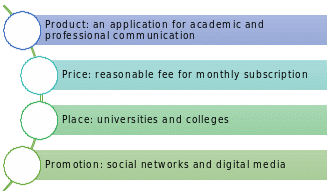Communication is one of the core needs of learners in the university setting. With the rising demand in the quality of produced work and the constant need for learning, the support of a community becomes overwhelmingly important for learners, as surveys and questionnaires taken from the target audience have shown. In addition, building the relationships that will support students in their future career development is essential.
The need for building a community and contributing to the effective communication between learners is the main rationale for Unihive to exist (Patacsil and Tablatin, 2017). The application will resolve two issues at once, allowing the process of knowledge sharing to become consistent and ensuring that students remain connected in the future, thus ensuring the development of their careers. Therefore, Unihive should be seen as an indispensable product for universities and similar academic organizations.
Market Analysis
The target market can be described as rather young yet quite promising. Specifically, the market for mobile apps for learners has been growing recently, especially for university ones (). The increase in the market size and share can be explained by students gaining financial freedom at the specified stage of their lives. In addition to a disposable income, learners also develop the need for staying in touch and sharing information, which increases market growth (). Overall, the market is not quite saturated and mature. Therefore, there is a lot of potential for the project in question.
Competitive Analysis
Several well-known companies have already been providing similar services to the target audience. For example, LinkedIn has been allowing students from all over the world to connect online (McCabe, 2017). However, the identified rivals seem to fail in helping learners to build a shared experience and create the setting in which their professional knowledge increases. While LinkedIn has contributed to building professional connections, it seems to have forgotten to establish options for effective communication. In turn, Facebook as one of the largest platforms for students has been ignoring the issue of professional development. Nevertheless, the two organizations in question make worthy competitors.
Marketing Plan
The market research has shown that students need an improved tool for professional connection despite the presence of other services providing opportunities for communication. The market size is moderate, and its growth is rather steep, which means that it will be possible to seize the moment. The target market can be divided into segments based on the users’ chosen area of professional interest, as well as their age and interests.
The product will be positioned as the application that will unite students across the globe, helping them to share knowledge and build their academic and professional knowledge (see Fig. 1). Therefore, it will need a marketing strategy to position it as the device for encouraging professional communication, active knowledge sharing, and building professional connections. The budget for the project will make a total of $100,000. A comparison of ROI before and after project implementation will be used as the main metrics.

Sales Strategy
Unihive will be sold to universities, colleges, and similar academic institutions as a tool for helping students create professional connections. Knowledge and experience sharing, as well as the development of social connections, will remain the priority within the Unihive context. Therefore, positioning the app as the device for helping students to build their professional life and manage the learning process will become the main sales strategy. It is anticipated that the app will become quite popular with students. Therefore, the financial projections are quite positive.
Reference List
McCabe, M. B. (2017) ‘Social media marketing strategies for career advancement: an analysis of LinkedIn’, Journal of Business and Behavioral Sciences, 29(1), p. 85.
Patacsil, F. F., & Tablatin, C. L. S. (2017) ‘Exploring the importance of soft and hard skills as perceived by IT internship students and industry: a gap analysis’, Journal of Technology and Science Education, 7(3), pp. 347-368.